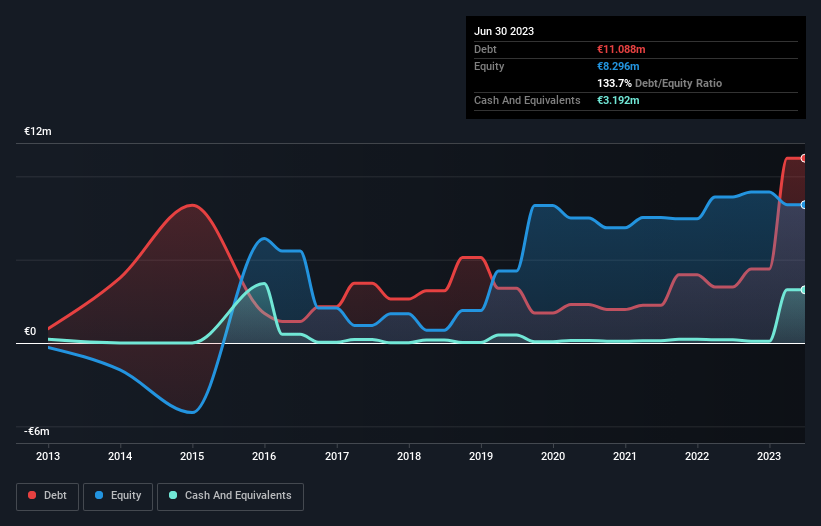
Some say volatility, rather than debt, is the best way to think about risk as an investor, but Warren Buffett famously said that 'Volatility is far from synonymous with risk.' When we think about how risky a company is, we always like to look at its use of debt, since debt overload can lead to ruin. We can see that KKO International SA (EPA:ALKKO) does use debt in its business. But the more important question is: how much risk is that debt creating?
When Is Debt A Problem?
Generally speaking, debt only becomes a real problem when a company can't easily pay it off, either by raising capital or with its own cash flow. If things get really bad, the lenders can take control of the business. However, a more usual (but still expensive) situation is where a company must dilute shareholders at a cheap share price simply to get debt under control. Of course, the upside of debt is that it often represents cheap capital, especially when it replaces dilution in a company with the ability to reinvest at high rates of return. The first thing to do when considering how much debt a business uses is to look at its cash and debt together.
View our latest analysis for KKO International
How Much Debt Does KKO International Carry?
You can click the graphic below for the historical numbers, but it shows that as of June 2023 KKO International had €11.1m of debt, an increase on €3.36m, over one year. However, because it has a cash reserve of €3.19m, its net debt is less, at about €7.90m.

How Healthy Is KKO International's Balance Sheet?
The latest balance sheet data shows that KKO International had liabilities of €7.52m due within a year, and liabilities of €10.1m falling due after that. Offsetting this, it had €3.19m in cash and €2.36m in receivables that were due within 12 months. So its liabilities outweigh the sum of its cash and (near-term) receivables by €12.1m.
When you consider that this deficiency exceeds the company's €11.2m market capitalization, you might well be inclined to review the balance sheet intently. Hypothetically, extremely heavy dilution would be required if the company were forced to pay down its liabilities by raising capital at the current share price. When analysing debt levels, the balance sheet is the obvious place to start. But you can't view debt in total isolation; since KKO International will need earnings to service that debt. So when considering debt, it's definitely worth looking at the earnings trend. Click here for an interactive snapshot.
In the last year KKO International wasn't profitable at an EBIT level, but managed to grow its revenue by 53%, to €1.0m. With any luck the company will be able to grow its way to profitability.
Caveat Emptor
While we can certainly appreciate KKO International's revenue growth, its earnings before interest and tax (EBIT) loss is not ideal. Its EBIT loss was a whopping €2.4m. When we look at that alongside the significant liabilities, we're not particularly confident about the company. It would need to improve its operations quickly for us to be interested in it. Not least because it had negative free cash flow of €4.4m over the last twelve months. That means it's on the risky side of things. There's no doubt that we learn most about debt from the balance sheet. However, not all investment risk resides within the balance sheet - far from it. Be aware that KKO International is showing 5 warning signs in our investment analysis , and 2 of those are potentially serious...
If you're interested in investing in businesses that can grow profits without the burden of debt, then check out this free list of growing businesses that have net cash on the balance sheet.
Valuation is complex, but we're here to simplify it.
Discover if KKO International might be undervalued or overvalued with our detailed analysis, featuring fair value estimates, potential risks, dividends, insider trades, and its financial condition.
Access Free AnalysisHave feedback on this article? Concerned about the content? Get in touch with us directly. Alternatively, email editorial-team (at) simplywallst.com.
This article by Simply Wall St is general in nature. We provide commentary based on historical data and analyst forecasts only using an unbiased methodology and our articles are not intended to be financial advice. It does not constitute a recommendation to buy or sell any stock, and does not take account of your objectives, or your financial situation. We aim to bring you long-term focused analysis driven by fundamental data. Note that our analysis may not factor in the latest price-sensitive company announcements or qualitative material. Simply Wall St has no position in any stocks mentioned.
About ENXTPA:ALKKO
KKO International
Through its subsidiary, operates a cocoa plantation worldwide.
Moderate with questionable track record.
Market Insights
Community Narratives



